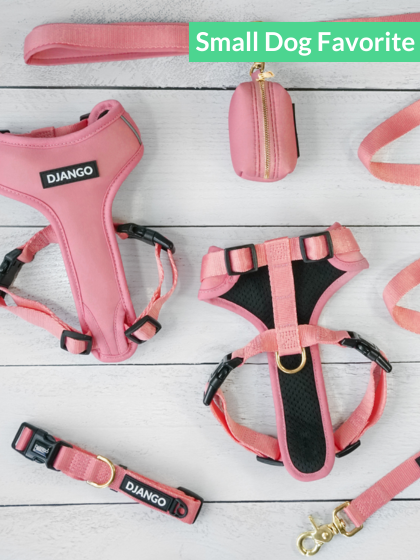What has been missing from dog diets ever since we started feeding them processed pet foods? Naturally occurring probiotics from whole foods, says Dr. Ian Billinghurst, the father of biologically appropriate, ancestral nutrition for dogs. Thirty years ago, he taught us about the evolutionary diet for dogs with his book, Give Your Dog a Bone. He also famously coined the term “BARF” (Biologically Appropriate RAW Food).
In this DJANGO Dog Blog article, we host Dr. Billinghurst and Rob Ryan, the founder of Gussy's Gut, for a conversation on good bacteria. Dr. Billinghurst and Rob Ryan also address why relying on probiotic supplements may not be the best long-term answer for our pups.
IN THIS POST:
- THE BENEFITS OF FERMENTED FOODS FOR DOGS
- FUNCTIONAL FOODS FOR DOGS
- THE DOWNSIDES OF PROBIOTIC DOG CHEWS AND SUPPLEMENTS
- PROBLEMS WITH PROCESSED PET FOODS
- THE MISSING LINK IN MODERN CANINE NUTRITION
- GUSSY'S GUT FERMENTED DOG SUPERFOOD TOPPER

THE BENEFITS OF FERMENTED FOODS FOR DOGS
In a nutshell, why should our dog’s diet include fermented foods?
ROB: It is actually very simple. Fermentation makes foods both more nutritious and delicious for dogs as it does for us.
Can you tell us more about fermentation, specifically for dogs?
DR. BILLINGHURST: Absolutely! Our favorite and preferred type of fermentation for dogs is what we call “wild fermentation”. Wild fermentation uses the naturally-occurring, fermenting organisms on foods.
Gussy’s Gut products contain a combo of plant and animal based ferments, such as grass-fed goat kefir. In both cases, we rely on lactic acid-producing bacteria, which occur naturally in the RAW foods we ferment. This is known as lactic acid fermentation (also known as Lacto-fermentation).
These lactic acid-producing bacteria are found in and on the plants, berries, and prey animals the ancestors of our dogs ate for millions of years. Today, many dogs that free-range on family farms also eat this way. This microbe-rich food includes the gut contents of prey animals. Those gut contents are highly fermented. This is the form of fermented food that our dog’s bodies cry out for, and this is what Gussy’s Gut provides in a very clean, safe, and health-promoting way.
What are the benefits of adding fermented foods to our dog’s foods?
ROB: I would have to say “optimization”. This wild fermentation process transforms superfoods into even more valuable, digestible, and useful nutrition for our dogs. Some people like to use the word “bio-available”. But your dog cannot benefit from what it cannot access.
Wild fermentation makes nutrients in superfoods more accessible. In essence, it creates these little “microfactories” that generate nutrients and bioactives with specific nutritional and health functionalities. Many of these do not exist in unfermented foods, including RAW Foods. These nutrients include vitamin K2, short-chain fatty acids, enzymes, and numerous others — most of which have not as yet been fully investigated by modern science.
Of course, what we are talking about here when we speak of these “microfactories” are the probiotics. They are good or beneficial bacteria and are a vital part of the microbiome. These microorganisms also break down food. so it is easier for our dog’s body to digest, absorb, and utilize. Another way to think about this: what good are any nutrients we think we are feeding if our dogs are not fully absorbing them?
Can you tell me a little bit about the science behind fermented foods?
DR. BILLINGHURST: Sure. The benefits come from the enormous number of reactions that take place during the fermentation process. These are catalyzed by the untold number of enzymes produced by the organisms that take part in the fermentation process. These reactions are able to not only break down the cellulose of plant cell walls. But they can also produce many new bioactives not present in the original material. At the same time, they make the nutrients that are there far more bioavailable in many ways. Sometimes, it is as simple as breaking them up into smaller, more easily digested molecules, such as peptides and amino acids. At other times, it is the addition of a carrier molecule. It increases their bioavailability, allowing them to pass more easily from the digestive tract into the bloodstream.
How can fermented foods improve your pup's overall health and gut microbiome?
Simply put, fermentation improves digestion and assimilation of our dog’s food. At the same time, it creates a myriad of health-enhancing nutrients not originally present in the food.
This means that if we compare fermented foods to their non-fermented counterparts, fermented foods confer multi-level benefits to dogs not provided by the original foods. These benefits include:
-
Improvements in digestibility
-
An increase in glucose tolerance, which means a decrease in insulin resistance
-
Inhibition of the growth of potentially pathogenic bacterial
-
A reduction of gastrointestinal disorders
-
A decrease in the risks of numerous degenerative disease processes, ranging from cardiovascular disease to allergies to cancer
FUNCTIONAL FOODS FOR DOGS
According to Healthline, "Functional foods are foods that offer health benefits beyond their nutritional value." Would you say that Gussy’s Gut could be best described as a functional food?
DR. BILLINGHURST: It depends on what you mean by functional food. If you mean a food that has a benefit well beyond what is currently known — then yes — definitely! Once the ingredients we use in Gussy’s Gut are fermented, they become super-wellness foods. For example, in the case of RAW vegetables, our dogs cannot extract their nutrients through normal digestive processes. Our dogs do not have the digestive enzymes to break down the cellulose in plant cell walls. They do not chew their food. Dogs are gulpers! Breaking down cellulose can only be accomplished through juicing or grinding — using a Vitamix, for example. However, once fermented, their value greatly increases.
ROB: Functional foods are a hot topic in the pet food sphere. But let me tell you what I think of them. Gussy’s Gut works backward from the desired effects or benefits. Then we look at what nutrients support them. Then we painstakingly research what foods contain those nutrients and are enabled by fermentation.
THE DOWNSIDES OF PROBIOTIC DOG CHEWS AND SUPPLEMENTS
That is pretty impressive. So why not then just use probiotic chews and supplements instead?
However, when you ferment whole foods, you will get trillions of probiotic organisms in just a handful of these foods — compared to just a few billion in a bottle of probiotics. In other words, these fermented foods are superior in every way. The number of organisms present is far greater and their value is enhanced exponentially by their nutrient-producing and assimilating abilities as an additional bonus.
Unfortunately, convenience can get in the way of people taking advantage of these benefits. For some pet owners, it is much easier to give powders, pills, or chews instead of feeding fermented foods. I might add that it is also cheaper. But we believe this a habit that can be solved by education.
The probiotic manufacturers have brilliantly addressed consumer wants. We contend this convenience is not a good long-term solution. Science shows that unchanging supplementation can lead to gut imbalances and dysbiosis (Leaky Gut) in perfectly healthy dogs. In other words, feeding a fixed, small set of the same species week after week after week has nowhere near the benefits of feeding a constantly changing source of beneficial bacteria. We have developed Gussy’s Gut to fill that nutritional gap. This is what our dogs’ bodies have evolved to require. Microbial diversity through living whole foods.
What about fecal transplants and pills through canine fecal material (or CFM)?
- What are the genetics, epigenetics, number of vaccinations, and diet of the source dog of this fecal material?
- Is this product capable of passing on genetic material to my dog that may not be beneficial?
- What testing and purification has this product undergone?
PROBLEMS WITH PROCESSED PET FOODS
Rob, you said before we began this interview that our dogs are satiated but starving. Can you elaborate on this?
ROB: Yes, sure. Our dogs are overfed and undernourished. Nutrition is not about looking or feeling fed or satisfied – or merely surviving. It is about being given the nutrients to thrive. Most dog foods on the market are just keeping our dogs alive — and even that is far shorter than it should be. The last years of their lives are often filled with one or more degenerative diseases. What their bodies need is the type of nutrition that will enable them to live long healthy lives. This lack of nutrients has reached epidemic proportions with most dogs now being fed artificial foods based on carbohydrates.
DR. BILLINGHURST: Can I say something about this as well?
Yes, please…
Cancer, diabetes, arthritis, and many other degenerative conditions, once considered to be diseases of old age are now appearing before our dogs reach maturity. This includes rare and unique cancers never seen until now in young dogs. My life's work has been to restore our dog’s bodies to the condition that nature has prescribed. This can only be achieved by returning our dogs to their original or ancestral diet. Put simply, we must "rewild" our dog’s diet and gut. This is the only way to genuinely ensure their maximum resistance to the disease and illnesses rampant in the canine population today.
These problems are caused in large part by a completely inappropriate diet. The modern pet diet is not only completely wrong in terms of its carbohydrate base, but it is also seriously lacking in genuine nutrition. Our dogs are indeed starving for nutrients. They are lacking, most particularly, in protective nutrients. These nutrients are only found in RAW whole foods. This includes fermented foods.
THE MISSING LINK IN MODERN CANINE NUTRITION
While manufactured dog probiotics are popular, they may not be the long-term solution. Can you tell me a little more about what it is you and Dr. Billinghurst are doing to address this unmet need?
ROB: Sure. We have created a pet product that is just as convenient as pills, powders, and chews. But it is in a live, whole food form. It is also far safer and far less uninviting than the type of fermented food a dog may choose if given half a chance. And by that, I mean such things as a buried bone, all rotten and smelly, or roadkill. It might be the gut contents of a prey animal, feces, or even something putrefying from a trash can. If left to their own devices, these are all examples of the less appealing materials that dogs will naturally source to get their microbiome “fix”.
Gussy’s Gut replaces all of these in a convenient safe and healthy manner. We ferment 19 superfoods together for 2 weeks and then freeze-dry them into a powder to make a super probiotic-rich food topper anyone can add quickly to any dog food.
Great. So, can you tell us a little more about how Gussy's Gut is made?
ROB: Yes. We use only human-grade organic produce from organic, biodynamic, and regenerative farms and as I said, ferment them for 2 weeks. We then move the product onto trays and freeze-dry them slowly for 30 hours. This method is very important for preserving the probiotic value of our product. It also adds at least $500 cost to each batch of product for that 30 hours. But it is not just worth it, it is essential.
Air dried or dehydrated powders will kill off all the benefits we are creating. From there, we gently ground the ingredients and add a dash of organic cheese. Which I should mention is also a fermented product. Then we package it for immediate sale. We produce only small batches on demand. This ensures our dog customers are getting the freshest product and not one sitting on shelves for 6-12 months like most pet food products.
How did this come about?
ROB: Well, I was taught how to feed my dogs by the best back in 1999, Dr. Ian Billinghurst. He and I did phone consultations. So, I have always included tripe and RAW grass-fed kefir, RAW goat milk, etc in my dog’s RAW diets.
But when my current dog Gus was suffering from gut issues after getting in the trash and swallowing a plastic bottle cap that wreaked havoc on his GI tract, I turned to make my own fermentation for him. I believe it saved his life. Then I got more and more elaborate and added more and more ingredients. I noticed his energy and stamina improved on his outings. He wanted to go on longer and longer hikes with me. People started to tell me his black coat looked so luxurious and “wet”. His stools were perfection. And he loved to eat it. But it got expensive, and I had to make a ton and give at least half of it away. I also got really tired of all the chopping and large 3-pint glass jars in my pantry fermenting for 2 weeks. I knocked a jar over a time or two, which frustrated me even more.
So, I took my experiences to Dr. Billinghurst. I knew he would understand. I wanted to ask him if this could benefit other dogs, if we could mass produce it, and if I should stop making it in my kitchen just for Gus. His feedback was one of surprise and excitement.
DR. BILLINGHURST: Yes, exactly. I told Rob this was the missing link to the ancestral diet I had prescribed some 30 years ago. This was the replacement we needed for all those stinky and awful things that dogs love to eat.
ROB: Yes, in fact, you told me, this is the most profound upgrade to canine nutrition in over 25 years.
DR. BILLINGHURST: That is right.
ROB: So, this was the best confirmation I could ever have. I knew right then, we needed to work together on this.

GUSSY'S GUT FERMENTED DOG SUPERFOOD TOPPER
What a great story. So, what are your products?
- Spinach
- Kale
- Parsley
- Cabbage
- Cauliflower
- Broccoli
- Beets
- Cilantro
- Dandelion
- Grass-fed Goat Kefir
- Wild Blueberries
- Milk Thistle
- Rosemary
- Oregano
- Turmeric
- Artichoke
- Decaffeinated Green Tea
- Alfalfa
- Kelp
ROB: All of those are both organic and fermented.
DR. BILLINGHURST: Yes! Very important. We designed this formula very carefully. We wanted something entirely suited for daily use. And with each ingredient doing more than double duty in its purpose or function, we have produced a truly functional food that is ideal as a food topper — no matter what you may be feeding your dog.
This food, you might say, has it all. It is full of prebiotics, antioxidants, phytonutrients, polyphenols, detoxifiers, and much more. With all of this, it is an incredible support for the liver. It is arguably one of the most important organs in the body in terms of digestion and assimilation of food. We wanted to support gut health, healthy aging, resilience, and above all, fill in the nutrition gaps of even the best diets out there. This product does all that and then some. I am proud to put my name and reputation on it.
Wow. That is very helpful. Thank you, Dr. Billinghurst. Rob, do you have anything you would like to add to that?
ROB: Well, that was pretty darn complete. I think the only thing I can add to that is, what we set out to do was provide a healthy spectrum of 180 whole food-derived vitamins, minerals, phytonutrients, fatty acids, amino acids, and enzymes. This goes way beyond other dog supplements that use the limited nutrient range suggested by AAFCO and other authorities.
Great thank you for that, Rob. You mentioned to me earlier that creating a pet product like this comes at a great expense. Can you share a little more about this?
ROB: Oh, sure, yes. Well, from the highest quality ingredients you can buy - literally - to the labor and freeze-drying. Making our Daily product is expensive. We make it all by hand in an organic certified kitchen. We cut no corners. Even the salt we use to ferment is the most expensive and best from a nutrition perspective.
We use Redmond’s Real Salt, which is mined from deep within the mountains of Utah. These were ancient sea beds free of any contamination from pollution or microplastics. We researched the heck out of salt and ancient sea salt was the best. It is also very high in trace minerals. Our dogs are mineral deficient like us. So even though we only use a little bit, it is additive to our nutrient profile. We also believe in paying above a living wage for our people.
As I mentioned, our freeze-drying method is important and adds a huge cost to each batch. But all of these things we do, we believe translate into a very premium pet product. We created Daily to be the best there is, and we plan to continue improving it over the months and years so it stays that way.
Does this replace adding fruits and veggies to your dog's food bowl?
ROB: No, not at all. It fills a nutritional gap that has been for the most part missing since dogs ceased to have access to bones, gardens to bury them in, and all those smelly items we mentioned earlier. I still add seasonal veggies to some of Gus’s meals. I add in ingredients not in Gussy’s Gut though. Also, because not all plants or fruits ferment well, these are often the ones I give him.
DR. BILLINGHURST: Let me step in here for a moment. Vegetables in their RAW, unfermented form have a separate role to play as part of the canine evolutionary program of nutrition. They become particularly important in the fight against degenerative diseases such as cancer and kidney disease. However, that is a discussion for another time. What I would like to emphasize at this time is the importance, when feeding vegetables, to do so in a state that makes them useful for our dogs. Whole or chopped is not that state.
ROB: Yes! They must be processed in either a blender or a juicer until they become like baby mush. This is the only way our dogs can reap the benefits of RAW vegetables. Feeding them in chunks or slices or even grated confers fewer nutritional benefits. In fact, Gussy’s Gut does well when mixed with pulverized vegetables and when used as a topper for RAW meaty bones or at mealtime.
We understand the vital importance of variety. Knowing that nutritional balance is best achieved over a period of time rather than at every meal. Taking 1-2 days off from feeding Gussy’s Gut can be beneficial. But no longer than that. In fact, from the point of view of economics, Gussy’s Gut can from time to time replace other things in your dog’s bowl.
What dog supplements and wellness products can Gussy's Gut replace?
ROB: For example, because of its brilliant properties for liver support and detoxification, it can be used in place of other products that do that job. For example, if used to replace a popular detox product made by Metagenics, you can save around $3.75 per serving.
If you are using an antioxidant supplement, then you may feel confident using Gussy’s Gut instead. This can save you around $1 per serving. And if you are replacing a probiotic supplement, this can add up to a saving of around $2-$3 per serving per day, depending on your dog’s weight, of course! Another one is Golden paste, which is really popular. With our organic turmeric being fermented, consider Gussy’s Gut as a replacement for that turmeric.
And of course, Gussy’s Gut is also an abundant source of fiber, so it has a role to play in creating those healthy firm stools dog parents much prefer to deal with. So, you can also save on fiber or stool-firming supplements. This means that the initial cost of Gussy’s Gut is very affordable when you take into account what can be saved in place of other supplements — up to $8 per day is entirely possible. And on top of Gussy’s Gut's value, it is a whole food and live supplement.
That is great. So what does Gussy’s Gut Daily cost per serving?
ROB: Yes, we think it is real value for money, given all those extra benefits. It retails for $89 if you buy one pack at a time (135 teaspoon servings). We recommend 1 teaspoon per 20 pounds of your dog's weight.
That works out to about $0.32 per day for small toy breeds under 20 lbs. About $0.66 per day for say a Jack Russell or Boston terrier. And for Labradors and Australian shepherds, about $1.97. Larger breeds range from $2.63 to as much as $4.50 per day for the really big dogs. And I would argue that it is the really big dogs who need nutrient-dense whole food products the most.
It takes a lot to live in a big dog’s body! So, this means that even with larger dogs, our customers can still save money with all that Gussy’s Gut can replace. And of course, it is a one-and-done supplement. You are doing a lot for your dog in one easy step.

Dog food costs keep going up along with most things. How can dog owners feed Gussy's Gut on a budget?
ROB: For anyone on a budget and especially with really big dogs, all food and supplements that support the health of our dogs can get expensive. So, we recommend giving our Daily formula every other day or even 1 teaspoon per 30 lbs. You can also get Daily for less by joining our email newsletter for special offers.
Conversely, for dogs that could use extra health benefits, you can add more by giving them double the amount - 1 teaspoon per 10 lbs. of their body weight.
DR. BILLINGHURST: The important thing is that it is given regularly. This is particularly so for dogs being fed processed dog foods. However, no matter what is being fed, the cumulative effect is profound.
That is very helpful. Is there anything else you would like to share with DJANGO Dog Blog readers?
DR. BILLINGHURST: Nothing is more important than nutrition for your dog’s health and length of life. If you can get that addressed, you can give your dog a chance for a bright, full life with you. If you want to take a step towards good health for your dog, start using Gussy’s Gut Daily.
And I strongly suggest switching your dog to a RAW whole food diet. I guarantee you will not be disappointed! Properly-formulated RAW whole foods combined with Gussy’s Gut is the holy grail of canine health.
ROB: I welcome everyone to join our email newsletter to learn more. We also sell a smaller 3 oz sample size, which can be a good jumpstart trial size for your dog. Just go to www.gussysgut.com. It is all there. And thank you for the opportunity to speak with you today!














1 comment
Hazel Wilia
Dogs should be fed with the best possible dog food along with several healthy food supplements as suggested by many vets because they can support your pet’s health in a number of ways. You can use supplements such as felo lysine, calcium now, and a lot more.
Dogs should be fed with the best possible dog food along with several healthy food supplements as suggested by many vets because they can support your pet’s health in a number of ways. You can use supplements such as felo lysine, calcium now, and a lot more.